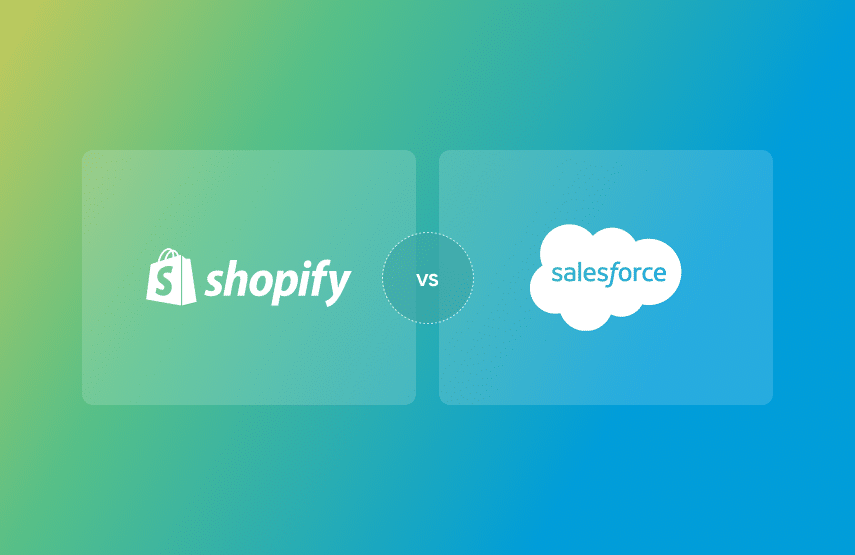Shopify Vs Salesforce: Too Big for Shopify, Too Fast for Salesforce?

In an increasingly crowded market, it’s essential that your business stands out by offering an online store that performs well and meets your customers’ needs. When looking for an e-commerce platform to achieve this, two options that appear are Shopify and Salesforce Commerce Cloud (previously Demandware).
However, Shopify limitations and Salesforce limitations can prevent you from reacting quickly to changes in the marketplace and providing digital shopping experiences that today’s customers expect. In this post, we’ll direct the limitations of Shopify and Salesforce and present some modern alternatives.
[toc-embed headline=”Shopify Vs Salesforce Commerce Cloud”]
Shopify Vs Salesforce Commerce Cloud
Whether you’re considering moving from Shopify to Salesforce, from Salesforce to Shopify, or from a custom e-commerce solution that is no longer tenable, weighing limitations with Salesforce vs Shopify will help you choose the right third-party e-commerce platform.
Shopify limitations
Shopify is one of the easiest e-commerce platforms to get up and running with. It’s an entirely hosted solution, meaning you don’t have to worry about managing your own servers or keeping your store running. All you have to do is add products to your store, make sure it has the right look and feel, and direct customers to your web address.
For the simplicity that Shopify provides, you’ll pay a fee, but for smaller stores and casual sellers, it can be a great option. You can get going quickly and validate that your e-commerce business is viable with real, paying customers.
The downside to an easy-to-use platform like Shopify is that it has some critical limitations for more mature businesses. Below are some of the limitations you’ll encounter when running your e-commerce business on Shopify.
CMS limitations
When it comes to design, Shopify is lacking so much so that Shogun has made a living on this deficiency. There is no landing or collections page in Shopify. Furthermore, you can only drag-and-drop design the home page. When it comes to formatting blog posts, the pre-built themes lack reliable tools for adjusting headers and sidebars.
Shopify’s Storefront API, its mechanism for going headless, is limited in functionality. This includes no bot protection and a heavy reliance on what the checkout can ingest.
Lastly, there is no staging environment available today, which limits crucial software testing. Most customers spin up a new instance and copy and paste over theme changes. Merchandising, promotions, and landing pages are not available in a true staging environment.
100 variant-per-product limit
For stores that are just starting out, this is not a big deal, but Shopify product limits block growth for many others. Shopify’s limit of 100 variants per product is an obvious deal-breaker for bigger stores. Workarounds for this require restructuring product hierarchy or an i-frame.
If part of the value proposition of your online store is providing customization to users around a core product—think t-shirts with many colors or patterns)—then you’ll have to add more SKUs and make your product catalog more complex just to work around this requirement. This can overcomplicate other parts of your fulfillment and order tracking process.
No product category levels
If your e-commerce store has highly nested taxonomies, you’ll be disappointed with the lack of Product Category levels that Shopify provides.
For example, if you run a clothing store and you want to provide a categorization schema such as Children’s > Pants > Jeans, the Shopify platform doesn’t offer a way for you to nest these product categories. Again, this speaks to Shopify’s target market but can lead to growing pains as your store expands. Similarly, if you are an established business with an existing product catalog, the lack of levels might require you to retool your product structure.
Payment gateway lock-in
While the Shopify Payments platform provides an easy way for merchants who aren’t used to accepting funds over the internet to get started with their online store, it isn’t perfect. Because you’re relying on Shopify to funnel revenue from your customers to your bank account, Shopify is ultimately in control of when and how you get paid.
There are numerous forum postings and complaints online (1, 2, 3) where merchants detail how they’ve had payments delayed and other various problems. For one, to support other payment methods like Google Pay, you must be using Shopify Payments. Although Apple Pay is available for other gateways, it is still relatively limited. If you decide to not use Shopify Payments, there is an additional 0.15% of fees (0.4% total) on top-line GMV, including shipping and taxes.
Shopify Payments also has limited support. For those wanting to sell in multiple currencies, there are many limitations. For refunds, Shopify keeps credit cards fees, rather than returning them to the customers. Fees also apply to chargebacks. These are the tradeoffs that you accept in exchange for the ease of use of getting up and running on an all-in-one, monolithic platform like Shopify.
Shopify Plus: This limitation applies to Shopify Plus as well.
Shopify app store
Unlike other plugin ecosystems like the WordPress Plugin Repository, the Shopify App Store does not allow you to view the source code of the applications you’re installing or see how they work. The only way to find out if a particular add-on will work for you is to read the documentation and reviews from other users before you install it.
This is definitely a limitation for established stores that don’t want to expose their large user base to potentially untested functionality. Imagine going through the experimentation process of installing and activating apps on your store, only to deactivate them later because they don’t provide the functionality you are looking for.
Shopify Plus: This limitation applies to Shopify Plus as well.
Solution to Shopify limitations
In contrast to these Shopify limitations, fabric is an e-commerce platform that’s easily customizable and developer-friendly due to its microservices-based architecture. Larger businesses can use the platform to build out their store in a way that works best for their business. fabric can easily import products, support unlimited product variants, and connect with third-party apps via API (better than app store plugins).
In addition, fabric’s headless commerce setup allows you to use any frontend—even one that already exists—which means existing e-commerce businesses can implement fabric without the huge risks that a major replatform can involve. Shopify offers themes to allow you to customize the frontend of your site, but your options for customization are much more limited.
Note: While Shopify Plus does offer a headless commerce option, you must still pay for the entire Shopify Plus platform—even for the parts you don’t use. Because fabric breaks its platform up into modules (i.e. microservices), you only pay for the modules you use. This is one of the largest differentiators between fabric and both Shopify and Salesforce.
Salesforce Demandware limitations
On the other end of the spectrum from Shopify is Salesforce Commerce Cloud, also known as Demandware. After acquiring Demandware in 2016, Salesforce rebranded it and seems to have slowed down dramatically on new developments.
The platform is a much larger platform built for enterprise customers, but it requires much more effort to get up and running. The level of customization and personalization they provide comes at the cost of setting up all these parameters. This can severely slow down your store’s time to launch if you are not already entrenched in the Salesforce ecosystem.
Below are a few noteworthy limitations to Salesforce Commerce Cloud.
Slow response times
Because many of Salesforce’s views are more complicated than something you’d find in Shopify, they also tend to be less performant. Especially in the admin panels, users and administrators may be frustrated with more sluggish performance than they would see with Shopify or a more streamlined platform like Fabric. This kind of slowdown often plagues enterprise-focused software that is saddled by legacy support or a lack of optimization.
Importing products is difficult
Some users have reported difficulties with importing their product catalog into Salesforce Commerce. This is definitely a knock against the platform since the users they are targeting are larger e-commerce stores with an existing product catalog that would need to be moved over.
Anyone moving a large set of products from either a traditional POS (point of sale) or an existing e-commerce store will be concerned with Salesforce Commerce’s lackluster import functionality, as robust import tools will allow you to get your product catalog moved quickly and easily.
Commerce is not a focus
Salesforce has many offerings serving many different customers (Heroku, Tableau, and most recently Slack), but at their core, they offer a CRM (customer relationship manager). Salesforce Commerce is not their main product and will likely never be as well supported as their core software offerings.
Shopify and Fabric are focused entirely on commerce because commerce is their business, while Salesforce has multiple divisions to split their resources between. When a business is split like Salesforce is, there’s always a risk that Salesforce Commerce Cloud could be sold off or shut down if it no longer provides enough value to the parent company.
Solution to Salesforce limitations
Fabric is solely focused on enabling custom commerce experiences for mid-market businesses and large companies. It offers software and support to help you migrate any product catalog painlessly and grow your business.
In contrast to a platform like Salesforce, Fabric empowers development teams to move quickly and delight their customers with its headless e-commerce experience and microservices-based architecture. Further, Fabric was created by general managers who worked at the largest e-commerce companies including eBay and Staples.
[toc-embed headline=”Which Solution Is Right for You?”]
Which Solution Is Right for You?
If you’re just beginning your journey as an e-commerce store and don’t have a development team behind you, check out Shopify. Be aware of its limitations, but rest assured that it’s a fine starting point for small businesses. Conversely, if you are already entrenched in the Salesforce ecosystem, Salesforce Commerce Cloud might be a good fit. Just know that you’ll have to live with legacy performance limitations.
That said, if you want the most flexible solution for building custom shopping experiences across channels, check out fabric. It solves many of the limitations imposed by traditional e-commerce solutions like Shopify and Salesforce Commerce Cloud. It also uses a microservices-based, API-first platform that allows you to choose the services you need and integrate them seamlessly with all your other internal or external services via a service mesh.

Tech advocate and writer @ fabric. CTO @ Alpha Particle. Previously developer @ How-To Geek and Doejo.